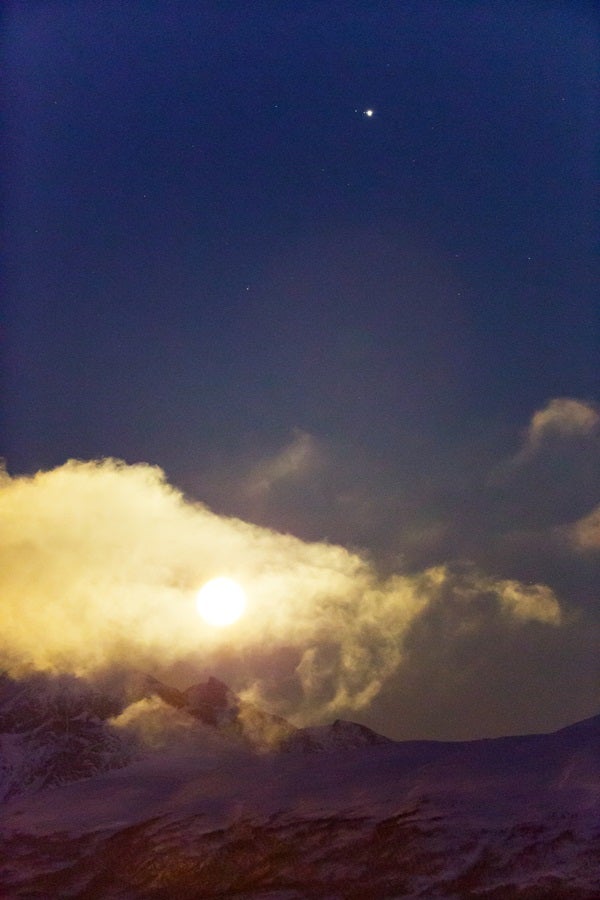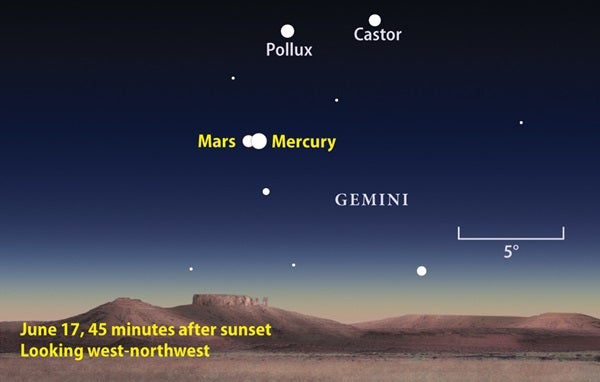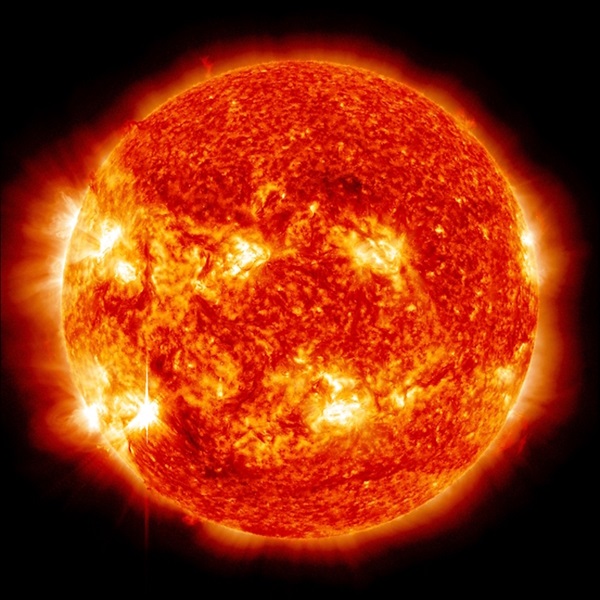Look high in the northwest after darkness falls this week and you’ll be greeted by the familiar sight of the Big Dipper. The Dipper is the sky’s most conspicuous asterism — a recognizable pattern of stars that doesn’t form a complete constellation shape. It represents the body and tail of Ursa Major the Great Bear. Use the Pointers, the two stars at the end of the Dipper’s bowl, to find Polaris, which lies due north for everyone north of the equator. Polaris marks the end of the Little Dipper’s handle. On June evenings, the relatively faint stars of this dipper arc directly above Polaris.
Saturday, June 15
Venus pokes above the horizon in the east-northeast an hour before sunrise. The brilliant planet shines at magnitude –3.8 and appears conspicuous in the predawn sky as twilight brightens. If you view the inner planet through a telescope, you’ll see a nearly full disk that spans 10″.
Sunday, June 16
Full Moon officially arrives at 4:31 a.m. EDT tomorrow morning, but it looks completely illuminated all night. It appears low in the southeast as the Sun sets and climbs highest in the south around 1 a.m. local daylight time. The Full Moon resides among the background stars of southeastern Ophiuchus, though residents in western North America will see it slide into western Sagittarius by daybreak. Don’t be surprised if your friends ask you what that bright object sitting next to the Moon is. You can impress them by answering Jupiter right away. The giant planet lies just 5° from Luna after sundown and a couple of degrees farther away by daybreak. Although the Moon detracts from the view of Jupiter tonight, return to the planet later this week for some stunning looks. The gas giant reached opposition last week and remains near its best. Gleaming at magnitude –2.6, it is the night sky’s brightest celestial object with the exception of the Moon and Venus, which doesn’t rise until morning twilight is well underway. It also stays visible throughout the night among the background stars of southern Ophiuchus. When viewed through a telescope, the planet’s disk spans 46″ and shows stunning cloud-top detail.
Mercury and Mars have a spectacular conjunction in evening twilight tonight and tomorrow. Mercury has been climbing higher these past couple of weeks while Mars has been dipping lower, setting up this dramatic meeting between the two smallest planets. This evening the two appear side by side with 28′ — just less than the Full Moon’s diameter — between them. At least that’s the separation as seen from central North America; the planets appear slightly farther apart from the eastern part of the continent and a bit closer from farther west. Mercury glows at magnitude 0.1 and will be easier to see than magnitude 1.8 Mars to its left. If you view the pair through a telescope, Mercury spans 7″ and appears half-lit while Mars shows a featureless disk some 4″ across.
Tuesday, June 18
The Moon’s relentless march across the sky carries it near Saturn tonight. The pair rises just before 10 p.m. local daylight time and climbs highest in the south between 2 and 3 a.m. The waning gibbous Moon appears only 1° south of the planet for viewers at mid-northern latitudes. Like Jupiter, however, Saturn appears best when the Moon lies farther away. The ringed world will reach its peak at opposition in three weeks, though it looks nearly as good now. It shines at magnitude 0.2 against the background stars of northern Sagittarius. If you target the world through a telescope, you’ll see its 18″-diameter disk surrounded by a beautiful ring system that spans 41″ and tilts 24° to our line of sight.
Mercury and Mars appear even closer to each other this evening, when the innermost planet stands 18′ apart above its neighbor. This is the nearest they have been to each other in the evening sky in 13 years. This conjunction is merely a line-of-sight effect — Mars is currently on the far side of the Sun from Earth while Mercury is on the near side.
Wednesday, June 19
The conspicuous Summer Triangle asterism dominates the eastern sky in late evening. Vega, the triangle’s brightest member, shines at magnitude 0.0 and stands highest of the three stars. To its lower left lies Deneb; at magnitude 1.3, it’s the faintest of the trio. Magnitude 0.8 Altair completes the bright asterism. Despite its name, the Summer Triangle appears prominent from late spring until the onset of winter.
Thursday, June 20
Observers of the outer solar system get their first good views of Uranus before dawn in late June. The best time to look for it is shortly before twilight begins around 3:30 a.m. local daylight time. Uranus then lies 10° above the eastern horizon among the background stars of southern Aries the Ram. This morning, use binoculars to find the magnitude 5.9 planet 2.4° south of the similarly bright star 19 Arietis. A telescope will help you tell the two apart — only the planet shows a blue-green disk that spans 3.5″.
Earth’s summer solstice arrives at 11:54 a.m. EDT, when the Sun reaches its farthest point north in the sky. This marks the official beginning of summer in the Northern Hemisphere, and the day of the solstice has more hours of sunlight than any other. For astronomy buffs, however, long days translate into short nights and extended twilight, which limit our time under the stars.
Neptune’s eastward motion against the background stars comes to a halt at midnight EDT. This so-called stationary point marks the beginning of the best period to observe any outer planet. Neptune rises around 12:30 a.m. local daylight time and appears about 30° high in the southeast as morning twilight commences. The magnitude 7.9 planet lies in Aquarius, 1.3° east-northeast of 4th-magnitude Phi (φ) Aquarii. You can confirm your sighting of Neptune through a telescope, which reveals the planet’s 2.3″-diameter disk and blue-gray color.
Saturday, June 22
This week offers a good opportunity for binocular users to track down the northern sky’s brightest globular cluster. M5, whose 100,000 stars glow at a combined magnitude of 5.7, lies in the southwestern corner of the constellation Serpens the Serpent. You can locate it just 0.4° north-northwest of the 5th-magnitude star 5 Serpentis. Binoculars show the cluster as a hazy ball of light punctuated by a bright core.
Sunday, June 23
Mercury reaches greatest elongation at 7 p.m. EDT, so today marks the peak of its current evening apparition. The innermost planet lies 25° east of the Sun and appears 11° high in the west-northwest 30 minutes after sunset. It shines at magnitude 0.4 and should show up easily to the naked eye, although don’t hesitate to sweep the area with binoculars to find its position. If you view Mercury with a telescope this evening, you’ll see that its 8″-diameter disk is about 40 percent lit.
The Moon reaches apogee, the farthest point in its orbit around Earth, at 3:50 a.m. EDT. It then lies 251,375 miles (404,548 kilometers) from Earth’s center.












